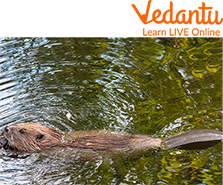




5 Fascinating Beaver Facts Every Student Should Know
Beavers are known for being extremely busy, and they use their skills to reshape the landscape in a way that few other animals can. Beavers dig tunnels in the banks of rivers and lakes when suitable locations are available. However, they also alter less favourable ecosystems by erecting dams. They make enormous log, branch, and mud structures to block streams and transform fields and forests into the big ponds that beavers like by felling and devouring trees with their strong teeth and muscular jaws.
Beaver
Where do Beavers Live?
They need water to survive. They occupy freshwater ponds, lakes, rivers, marshes, swamps, and nearby areas. American beavers are found all over North America, but they avoid deserts and Canada's most remote regions. Historically, Eurasian beavers inhabited all of Europe and Asia. Due to overhunting, they are now only found in tiny numbers in southern Scandinavia, Germany, France, Poland, and central Russia.
A lodge is a beaver's house. Lodges are tiny, dome-shaped structures covered in mud and constructed with woven sticks, grasses, and moss. According to ADW, they have an interior that is up to 3 feet (1 m) high and up to 8 feet (2.4 m) broad. Lodges are constructed slightly above water level on islands, pond banks, or lake edges. Many resorts include an underwater entryway that provides quick access to the water.
Beaver’s Home
Beaver’s Habitat
Beavers are mainly nocturnal animals. They eat and build most of the time. Beavers build dams to create ponds, which are their preferred habitat. When making a dam, branches are woven together, trees are felled using their teeth, and the structure is then waterproofed with mud. According to ADW, dams can be up to 6.5 feet (2 metres) high and several metres in length. In order to transport water from big bodies of water to their feeding location, beavers also create canals.
Ecosystems are significantly impacted by beavers. Dams can flood hundreds of acres and change the course of rivers. According to ADW, dams reduce erosion and elevate the water table, which contributes to water purification since silt accumulates and breaks down contaminants. Carbon levels rise, and nitrogen levels fall as silt and trash accumulate. Invertebrates change type due to chemical changes, and new birds, fish, and amphibians are drawn to the new water source. Flooded wood decays, transforming a forest into an ecosystem with open water.

Beaver Floating in the Water
Beavers Facts for Kids
Now, let us look at some interesting facts about beavers:
After birth, American beaver kits can swim.
Beavers are built for life in the water. At 5 mph, their webbed feet and rudder-like tail help them move through the water (8 kph). Additionally, according to National Geographic, they can submerge themselves for up to 15 minutes at a time.
They use their tails for more than just swimming. Beavers also slap the water with them as they dive away from danger to frighten predators.
They don't hibernate, beavers. Throughout the winter, they carry on with eating and building.
The pope authorised the consumption of beaver during Catholic fasting days in the 16th century because of its scaly tail and semi-aquatic existence, according to ADW.
Beavers eat trees and woody plants; they prefer the inner bark of the trees along with the bark and leaves. Twigs, apples and shrubs are also included in their preferred food.
Beavers are usually of no danger, but if they face an enemy or if they are trapped by any human, they may bite the human, and their bite can cause serious injury and infections as well.
An average lifespan of a beaver can be up to ten to 12 years.
Beaver at the Shore
Summary
In this article, we have learned a lot of interesting facts about beavers. We also learned that the largest and most distinguishing characteristic of beavers is their long, flat tail, which also acts as a fat storage area for the winter and a prop when sitting or standing upright. Additionally, to warn other beavers of danger or just for fun, beavers will slap their tails on the water's surface.
We also got to know about their habitat and their home, and we also learned some facts about beavers. Now, we are aware of this rodent that generally lives in ponds, lakes etc. I hope this article will be beneficial for you. In case of any queries, feel free to ask in the comments.
FAQs on Where Do Beavers Live?
1. Write about the conservation of beavers.
Since beavers were previously prized for their pelts, castoreum, and meat, they were almost completely eradicated via hunting. Castoreum was a substance used in food, medicine, and perfumes, and beaver hats were once the height of fashion. The International Union for Conservation of Nature (IUCN) no longer classifies beavers as endangered. They are widely distributed, frequent throughout much of their habitat, and their populations are steady.
2. Write about the classification of beaver.
Kingdom: Animalia
Subkingdom: Bilateria
Phylum: Chordata
Subphylum: Vertebrata
Superclass: Tetrapoda
Class: Mammalia
Order: Rodentia
Genus: Castor
Species: Castor canadensis
3. Write about the mating of beavers.
Between January and March in the winter, beavers mate. The gestation period for the Eurasian beaver ranges from 60 to 128 days. Then, according to ADW, they give birth to one to six infants that range in weight from 8.1 to 22 ounces (230 to 630 grams). Beaver cubs are known as kits. Typically, Eurasian kits are weaned six weeks after birth.
The gestation time for American beavers is between 105 and 107 days. One to four kits weighing between 9 and 21 ounces are born (250 to 600 g). American beavers often wean in two weeks or less. The kits depart the lodge and build one of their own around the age of two. They locate a monogamous mate at the age of 3.









